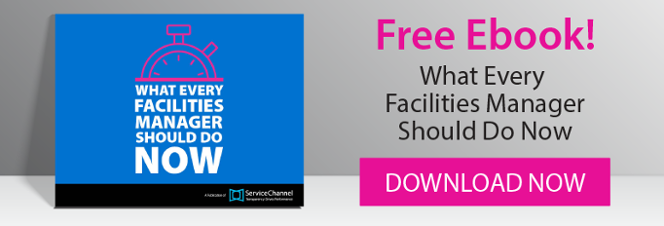2017’s Crystal Ball for Facilities Management

Most folks agree that 2016 was quite a year. What does 2017 have in store? And diving into our little neck of the woods, what will impact the facilities management sector and how will it change?
To get some insight, we’ve put together a collection of predictions from a number of the ServiceChannel team. While we can’t guarantee 100% accuracy (or we’d likely be doing something different!), these come from our deep FM experience and continual engagement with over 400 customers across various functions, industries and in all aspects of the facilities and maintenance sectors.
Whether it’s the Internet of Things to autonomous equipment, predictive maintenance to asset based maintenance, emerging and existing technologies are driving change across the facilities management landscape. Regardless of the timing on these, they all raise important developments and trends that you should be aware of, as each is likely to impact your company – and your role – sooner than later.
Internet of Things Impacting Consumer Behavior
Internet of Things (IoT) devices like Amazon’s Alexa and Google Home will change the way people interact with their homes and surroundings, impacting consumer behavior and further blurring the line between the brick and mortar experience and IoT integration.
For example, imagine being at a brick and mortar Apple retail outlet or Best Buy store. You go to the laptop display or bank of TVs and select the one you want. Then, without any interaction from the store staff, you simply swipe your iPhone with ApplePay in front of the price tag and purchase the device right then and there, to be automatically delivered to your house and set up for you.
Retailers will find that physical locations remain a crucial part of their business (and thus maintaining a modern, inviting and exciting customer experience is paramount). In fact, even online-only retailers will move to the physical world. Even though they may not necessarily drive sales exclusively at their locations, this ‘real life’ presence will be necessary to drive sales on an overall basis.
— Jake Rehmann, Regional Sales Manager
More Mobile Impact on Maintenance Process
Mobile seems to be top of mind for most people, especially in the facilities space. Mobile work orders, mobile approvals, history, notes, even site surveys will increasingly become part of the overall FM mobile functionality. Facilities managers will wonder how they ever did their job without their devices!
— Dave Perry, Sales Director
Drone Technology Providing Property Overviews
Drones will be used even more frequently to offer a bird’s-eye view of properties. With drone technology becoming more accessible, it will be routinely applied in order to facilitate conversations between location managers and service providers by supplying real-time, comprehensive overviews of expansive, complex or difficult to reach areas.
— Erika Young, Product Manager
Smaller Stores and Autonomous Equipment
Driven by consumers’ desire for convenience and the availability of free shipping, online shopping will continue to increase. This will cause stores to get smaller and turn into return centers, since roughly 30% of gifts purchased are returned each year. There are lots of benefits of smaller stores: lower heating and cooling costs, electricity, staffing, cleaning, etc.
If cars can drive themselves without people, why can’t we program shopping carts for the items we want, have them go around the store, stop at the item, put the item directly into the grocery bag, and automatically check out. No more need to wonder what aisle a product is in, an autonomous shopping cart would know and go through the store in the most efficient manner.
Drone usage continues its up-tick as a tool for use by facility managers to inspect roofs, chimneys, cooling systems, high-rise exteriors, etc.
— Andy Brown, Vice President, Product Management
Asset-Based Facilities Maintenance
A combination of two factors – proliferation of smartphones into the hands of technicians and maturing of NFC tagging technology – will finally make asset-based facilities maintenance for distributed properties a realistic and a necessary proposition. How will this change things?
Before: Technician needs to find a tag or a serial number of the asset, writes it down on paper work order along with the resolution text; office clerk receives a paper work order, checks if the asset is already in the database, adds if not there, enters hours worked, parts used and resolution text manually. This process was tremendously inefficient and never worked.
Now: Technician taps on the NFC tag and the mobile application records what asset is being repaired. After the repair, the technician taps again, the app records the hours spent on site, and the technician selects the resolution codes specific to the asset along with the parts used. Everything gets recorded and goes into the database automatically.
— Serge Lubensky, Founder and CTO
 Competition Driving Broadening of What Retailers Offer
Competition Driving Broadening of What Retailers Offer
Most retailers have a very watchful eye on e-commerce as their number one competitor. These retailers are looking to combat this in several ways. First, they need to ensure they have an online presence with a very user-friendly and robust on-line store to represent their business. Second, they need to find new ways to drive customers to their stores and keep them there longer.
One way retailers are doing this is by looking to add experiences like food, beverage, classes, etc. to their locations. Lastly, they will increase facilities repair and remodel budgets to improve the condition of their locations to ensure the customers have a great experience and are more likely to return.
— Eric Schechter, Executive Director, ServiceChannel Ventures
Security Concerns Driving Location Access Checking
Unfortunately, security concerns have become a way of life. And this past year has shown us that travel hubs (e.g. train stations, airports, bus depots, cruise/shipping docks) can be a particular point of vulnerability.
So in addition to passenger screening, travel hubs will need tools to enable contractor and service provider screening. They’ll want additional identification from contractors and provider verification before granting access to their facilities and locations.
— Jordan Moskowitz, Marketing Manager
Increasing Payment Process Efficiencies and Leveraging Big Data
With hundreds to thousands of incoming invoices from all types of service providers each month, payment processing for most multi-location organizations is typically a highly inefficient – and thus costly – endeavor. New service automation tools focused around these payments will bring further automation and make the process much more efficient and cost-effective than most facilities departments experience today.
Big Data’s not new but we’re really just scratching the surface of what can be done with all this information. As more data’s collected and more analytic and business intelligence tools focused on the facilities sector are developed, there’ll be more opportunities to drive real business business value from leveraging more advanced big data, like marrying FM data with data from other departments, organizations and external sources such as store traffic and revenue, weather data, etc.
— Tom Buiocchi, CEO
Tracking Technician Performance Objectively
 2017 will be the ‘Year of the Technician’ in the FM world. For the first time, companies will be able to track technicians and their performance quantitatively as it pertains to the work performed on-site, providing performance granularity down to the individual level.
2017 will be the ‘Year of the Technician’ in the FM world. For the first time, companies will be able to track technicians and their performance quantitatively as it pertains to the work performed on-site, providing performance granularity down to the individual level.
In addition, service providers and contractors themselves will be able to monitor similarly their own workforce performance (per technician) as they know their own company performance is only as good as the techs they employ.
— Gregory Rakovsky, Product Manager
Smarter Systems for Predictive Maintenance
Big data will become increasingly important and software systems will start to get smarter because of it. With all of the data that is – and will increasingly be – swirling around, people will start to take more advantage of it by creating systems that can predict issues earlier on (“predictive maintenance”). This will have a big impact on the FM business by preventing emergencies before they happen and providing more efficient preventive maintenance or budget planning.
One small example of this would be the ability to predict an increased spend on door repairs (or a need for more robust door hardware) in areas like Chicago. With the high winds in these areas, doors get caught in the wind when they are opened more often, and their hinges can be damaged in the process. Software systems will start to recognize these patterns and help FMs plan more accurately for these situations.
— Greg Wilson, Product Manager
AI Beginning to Transform Facilities Management
Emerging AI-like tools and software applications will start transforming the facilities space as facilities managers start getting exposed to data-driven recommendations. Executives will start thinking of redefining the facilities manager’s role in the FM space. It will start small but lay the groundwork to be more suggestive and predictive on every decision point across a facilities program.
— Mike Yang, Product Manager
Data-driven Decision Making Increasingly the Norm
Data driven decision making will become the norm. Gut decisions will become a thing of the past with information and intelligence being easier to access than ever before. Automating FM processes will play an even more critical role as teams look to be more efficient and lead in today’s competitive retail environment. And data will play a bigger and bigger role in advancing automation with smart applications transforming how teams are able to leverage their data.
— Sid Shetty, Vice President Marketplace Strategy & Experience






